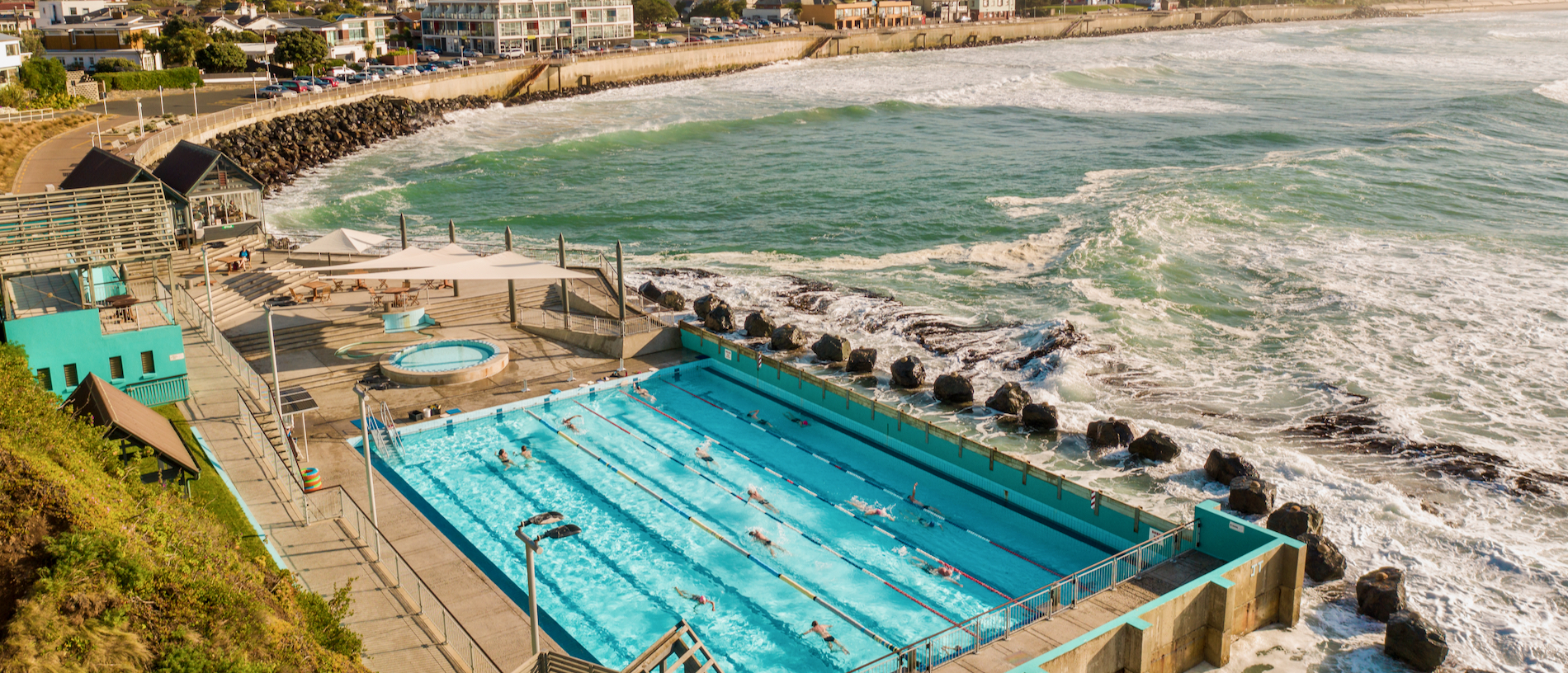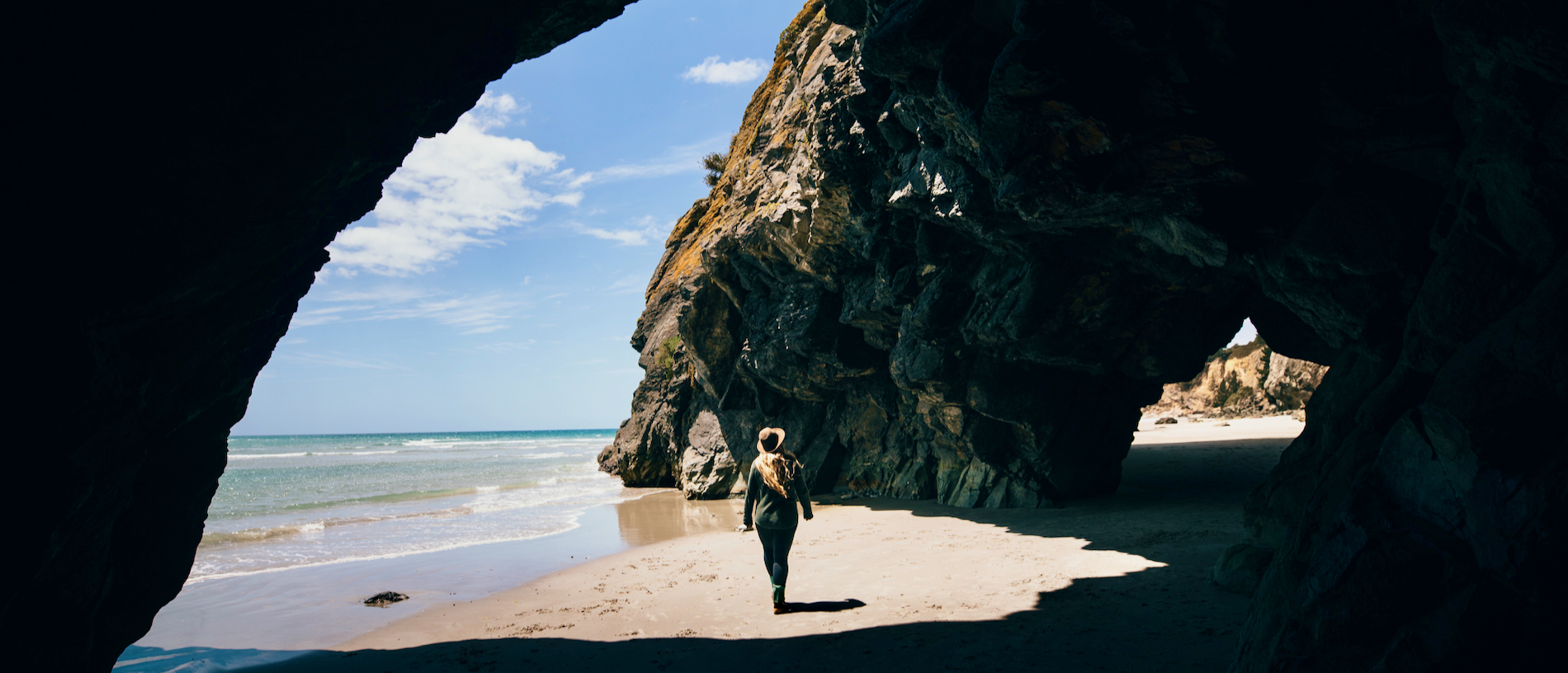
Swim at St Clair Hot Salt Water Pool
Alongside New Zealand’s most consistent surf break, Dunedin’s St Clair Beach is also home to one of the country’s few heated saltwater pools.

From the beautiful white sand beaches around Dunedin to intriguing gold-mining heritage in Central Otago, incredible geology, Māori history and New Zealand's only historic car ferry punt, check out these 12 Kiwi Gems in the Otago Region.
From the 1860s until the 1920s Kamau Taurua Quarantine Island, in between Portobello and Port Chalmers in Otago Harbour, hosted a quarantine station for incoming European settlers. It was also home to a military hospital during WWI. Today on the island you’ll find the historic Married Quarters, one of two striking built landmarks. The other is the small, modernist chapel, constructed to serve the needs of the St Martins congregation who established a community there in the late 1950s (when it became known as St Martins Island for a time). Now a Department of Conservation reserve, Quarantine Island is free to visit for a wander around and a picnic, or you can stay overnight in the caretaker’s cottage. Open days happen once a month with organised boats across the harbour, but on any other occasion your best bet would be to make contact with Port To Port Tours.
A small, private museum in the central Dunedin home of artist and sculptor Bruce Mahalski, The Dunedin Museum of Natural Mystery is an enthralling mishmash of artefacts spread over three rooms of his Victorian villa. Bursting with unusual skulls and bones, rare taxidermied animals, paintings, sculptures and other biological, zoological, botanical and ethnological curiosities, the museum is the result of a lifetime of intrepid collecting. Almost every item has a story behind it with weird and wonderful exhibits including a tin of whale meat from North Korea, a Gloriavale uniform and a piece of wood from the most haunted house in England. Entry is by koha.
With walking tracks, white sandy beaches and cool sea caves to explore at low tide, Doctor’s Point is one of Dunedin’s best hidden beaches. Doctor’s Point Reserve is found in Blueskin Bay, a short drive from Waitati, north of Dunedin. Walk through the soaring sea arches, also known as Taoka's Arches – which are kind of like the Cathedral Cove of the South Island – to reach Mapoutahi Head, the site of a historic Māori pā.
The Organ Pipes provide one of those head-scratching moments of wonder only nature can deliver. A thatch of hexagonal columns that once were lava, their peak offers spectacular views to the north of Dunedin. Drive up and park at Mount Cargill, a fine vantage point in itself, and hike in from there. Allow an hour for your troubles, a little longer if you want to stop off at Butters Peak on the way. The 2km Organ Pipes track links with the Mount Cargill Walking Track, with some steep sections and rock scrambling required.
Once the stronghold of Te Wera, the fortification at Karitane on the coast north of Dunedin, was under siege for months in the 18th century – one of many battles between Te Wera and his cousin Taoka. Family, eh? The 2.5km loop track is well formed and easy going, offering great views up and down the wild Otago coast. If you want your local storytelling a little more personalised, Karitane Māori Tours offer guided walking tours of the peninsula, or if you were more keen on exploring at sea level, waka tours on the Waikouaiti River.
The sculpted clay cliffs and pinnacles at the Bannockburn Sluicings near Cromwell are the result of a five-decade-long gold mining era that began in the 1860s. They were formed by hydraulic sluicing, which involved water being blasted at the hills to release alluvial gold. A 15-minute trek gets you to the entrance of a little valley of caves, tunnels and rock tailings left untouched since it was abandoned by the last of the mining men. Keep an eye out for remnants of stone and earth houses, the blacksmith shop and caves and rock shelters where the poorest miners once lived. To get the full experience, follow the well-signposted two-hour return track that takes you past the remains of Stewart Town. This small settlement contains an old miner’s stone cottage, a dam and old water races that used to take precious water to the mining sites. There’s even an orchard that still yields pears and apricots in season, incredible when you consider that it was planted in 1906!
Alongside Lake Aviemore you’ll find the Deep Stream Track. A lovely walking trail in its own right, with a well-formed track and a few sections of stairs, it’s also a beautiful spot for a dip in the hot summer months. The ‘deep stream’ is a flooded canyon of rugged rock filled with dark green water. Generally sheltered from the wind, it’s also a great place for kayaking and paddle boarding away from the buzz of motorboats on Lake Aviemore, and is generally sheltered from the wind. To get there, turn off SH83 at Aviemore Dam onto Te Akatarawa Road.
Not far from Duntroon in Otago’s Waitaki District, you’ll find a limestone cave and rock formations decorated with ancient art works. Takiroa is a protected landmark and significant site for Ngāi Tahu, showing how the first people of this area travelled and lived hundreds of years ago. Paintings made from charcoal and red ochre depict abstract forms, birds, animals and people. While the first origins of the rock art are unclear, it is believed they were created in two distinct time periods, pre- and post-European settlement.
If you’re a fan of Kiwi ingenuity, rural inventions and workshops crammed with heritage machinery, then check out Hayes Engineering Works and Homestead near Oturehua. This heritage site was once the home of prolific inventor Ernest ‘Ernie’ Hayes whose speciality was inventing and perfecting labour-saving devices to help with life on the farm. From rabbit bait cutters to windmills, Ernie’s products became sought after both at home and overseas. His best-known achievement was the refinement of the fencing wire strainer – farmers around the globe use it to this day to keep their fences strong and straight. Today, Ernie’s workshop is preserved just as he left it. Make sure you also explore the family’s 1920s homestead. Filled with a treasure trove of domestic devices that were well ahead of their time in rural New Zealand, the house features an indoor flush toilet, overhead shower and the likely first in-home sound system connecting each room to radio and messaging.
The pub is at the heart of many rural communities, but few have taken it as seriously as St Bathans’ residents, all 22 of whom voted in favour of 10pm closing in 1967. As well as being well-appreciated by locals, the Vulcan Hotel (est 1882) is a magnet for globetrotting ghostbusters, thanks to the recurring presence of Rose in room one. Other features of this picturesque town include mud brick houses and a town hall, also of mud brick, which is the longest-serving hall in the country. Right next to the township is the dazzling, human-made Blue Lake. Originally St Bathans lay in a small gully but after years of extensive mining, Kildare Hill was flattened and by 1934 mining was stopped as the pit was getting too close to town. By 1936 the lake had formed, with the bottom sitting more than 40 metres below the town’s main street.

Did you know that you can cross the Clutha Mata-au River by punt? At the small settlement of Tuapeka Mouth, a 25 minute drive from Lawrence, you’ll find this unique ferry service that has been operating since 1896. The Tuapeka Mouth Ferry is a floating platform big enough to fit a couple of cars that's attached to pontoons. Several times a day, depending on river levels, the punt shuttles from one side of the river to the other using an overhead cable system to resist the current. The best part? Catching a ride on the punt is free.
Head to Otago’s southern coast from Milton to find one of the region’s most stunning beaches. Chrystalls Beach is a vast sweep of coarse golden sand with wild waves that you’ll more than likely have to yourself. The rocky outcrop here is know as Cook’s Head Rock, which provides a great vantage point to survey the endless blue ocean. While the waves may look tempting, Chyrstalls Beach is renowned for its nasty rips, so swimming is not recommended. Keep an eye out for local wildlife, too, as sea lions are often spotted here.